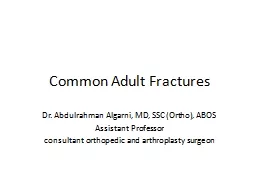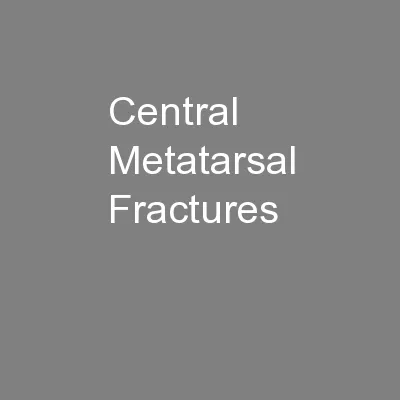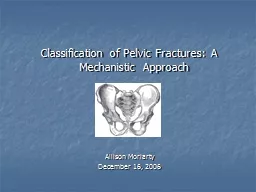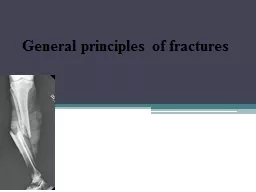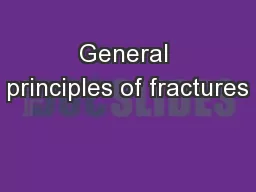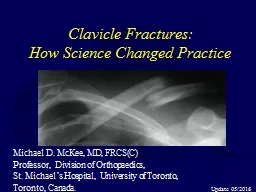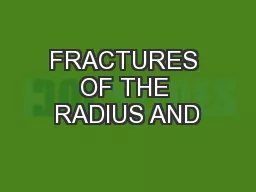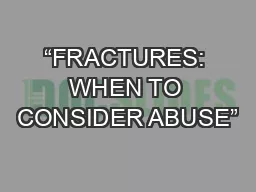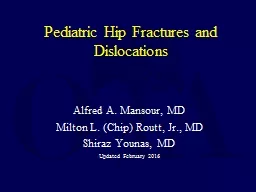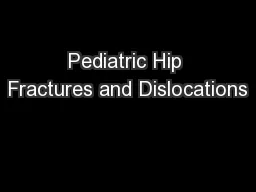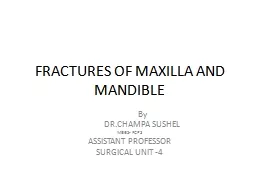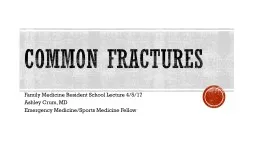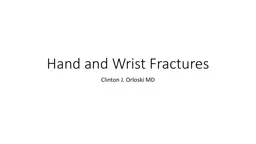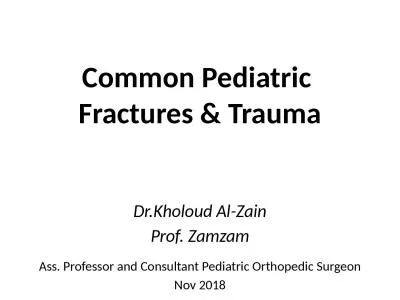PPT-Common Adult Fractures
Author : jane-oiler | Published Date : 2017-04-25
Dr Abdulrahman Algarni MD SSC Ortho ABOS Assistant Professor consultant orthopedic and arthroplasty surgeon objectives To know the most common mechanisms of
Presentation Embed Code
Download Presentation
Download Presentation The PPT/PDF document "Common Adult Fractures" is the property of its rightful owner. Permission is granted to download and print the materials on this website for personal, non-commercial use only, and to display it on your personal computer provided you do not modify the materials and that you retain all copyright notices contained in the materials. By downloading content from our website, you accept the terms of this agreement.
Common Adult Fractures: Transcript
Dr Abdulrahman Algarni MD SSC Ortho ABOS Assistant Professor consultant orthopedic and arthroplasty surgeon objectives To know the most common mechanisms of injury Be able to make the diagnosis of common adult fractures. Fractures Peculiar to Children. Torus or buckling. Greenstick. Bowing. Epiphyseal. Often only incomplete fracture line is seen. Fractures Peculiar to Children. A. B. C. D. Torus Fracture Radius. Torus Fracture Radius. Dan Preece DPM, PGY-1. Stress . Fx. Frequency /Distribution: . -. second metatarsal 52%. -. third metatarsal 35%. -. first . metatarsal . 8%. -. fourth . and fifth metatarsals . 5%. **shorter . first metatarsal of Morton's foot . Allison Moriarty. December 16, 2006. Outline. Epidemiology. Anatomy. Imaging. Classification. Complications. Treatment. Epidemiology. Only 2-3% of all skeletal fractures . Most result from high energy trauma . A . fracture . is a break in the structural continuity of bone. It my . be . no more than a crack, a crumpling or a splintering of the cortex; more often the break is complete and the bone fragments are . A . fracture . is a break in the structural continuity of bone. It my . be . no more than a crack, a crumpling or a splintering of the cortex; more often the break is complete and the bone fragments are . How Science Changed Practice. Michael D. McKee, MD, FRCS(C) . Professor, Division of . Orthopaedics. , . St. Michael’s Hospital, University of Toronto,. Toronto, Canada. . Update 05/2016. ULNA. Mechanism of injury and pathology. Fractures . of the shafts of both forearm bones . occur quite . commonly. . A twisting force . (usually a fall on . the hand. ) produces . a spiral fracture . ARNE GRAFF MD. MAYO CLINIC-ROCHESTER. OBJECTIVES:. RECOGNIZE RISK FACTORS ASSOCIATED WITH ABUSE. DEVELOP EVALUATION PROCESS. HOW TO DEVELOP AN IMPRESSION. DISCLOSURE:. NONE. DO PARTICIPATE IN COURT CASES FOR BOTH THE DEFENSE AND PROSECUTORS. Alfred A. Mansour, MD. Milton L. (Chip) Routt, Jr., MD. Shiraz . Younas. , MD. Updated February 2016. Objectives. Review relevant pediatric proximal femoral development and anatomy. Review the types of pediatric hip fractures. Alfred A. Mansour, MD. Milton L. (Chip) Routt, Jr., MD. Shiraz . Younas. , MD. Updated February 2016. Objectives. Review relevant pediatric proximal femoral development and anatomy. Review the types of pediatric hip fractures. FRACTURES OF MAXILLA AND MANDIBLE By DR.CHAMPA SUSHEL MBBS- FCPS ASSISTANT PROFESSOR SURGICAL UNIT -4 Etiology Maxillofacial fractures result from either blunt or penetrating trauma. Ashley Crum, MD. Emergency Medicine/Sports Medicine Fellow. objectives. Identify common fractures in upper and lower extremities. Treatment . Urgent vs Non-urgent . referal. Physical Exam pearls. Try to understand the mechanism of injury from the history. Clinton J. Orloski MD. Common Fractures. 4. th. and 5. th. Metacarpal Fractures (“Boxer Fractures”). Distal Radius Fracture (”. Colles. Fracture”). Scaphoid Fracture (also beware of pain at snuffbox . Dr.Kholoud Al-Zain. Prof. Zamzam. Ass. Professor and Consultant Pediatric Orthopedic Surgeon. Nov 2018. Objectives. Introduction. Difference between Ped & adult . Physis. # . Salter-Harris classification.
Download Document
Here is the link to download the presentation.
"Common Adult Fractures"The content belongs to its owner. You may download and print it for personal use, without modification, and keep all copyright notices. By downloading, you agree to these terms.
Related Documents

